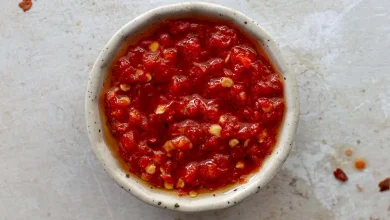🍤🍝 Anaheim Shrimp Scampi 🍤🍝
Anaheim Shrimp Scampi is a delicious and flavorful seafood dish that combines succulent shrimp with a garlicky, buttery sauce. This dish is not only mouthwatering but also easy to prepare. Let’s dive into its history, components, preparation steps, and time needed to make it.
📜 History:
The term “scampi” originally referred to a type of small lobster found in the Mediterranean Sea. However, in many parts of the world, especially in the United States, “shrimp scampi” has become synonymous with a preparation style rather than the specific seafood used. It’s a classic Italian-American dish that likely evolved from Italian recipes and gained popularity in the U.S. during the mid-20th century.
🍽️ Components:
To make a delicious Anaheim Shrimp Scampi, you’ll need the following components:
- Shrimp: Fresh or frozen large shrimp, peeled and deveined.
- Butter: For that rich and creamy flavor.
- Olive Oil: Adds depth to the sauce and helps prevent the butter from burning.
- Garlic: Lots of minced garlic for that classic scampi flavor.
- White Wine: Dry white wine is traditionally used to deglaze the pan.
- Lemon Juice: Freshly squeezed lemon juice for a zesty kick.
- Red Pepper Flakes: For a hint of heat (optional).
- Parsley: Chopped fresh parsley for garnish.
- Salt and Pepper: To season the dish.
👩🍳 Preparation Steps:
-
Prepare Shrimp: Ensure the shrimp are peeled and deveined. Pat them dry with paper towels and season with salt and pepper.
-
Heat Pan: In a large skillet or pan, heat a mixture of butter and olive oil over medium-high heat. Add minced garlic and red pepper flakes if you want some heat. Sauté until the garlic becomes fragrant.
-
Sear Shrimp: Add the seasoned shrimp to the pan in a single layer. Cook for about 2-3 minutes per side or until they turn pink and opaque. Remove them from the pan and set them aside.
-
Deglaze Pan: Pour in white wine and lemon juice to deglaze the pan. Scrape up any browned bits from the bottom of the pan with a wooden spoon. Allow the sauce to simmer and reduce for a few minutes.
-
Combine: Return the cooked shrimp to the pan and toss them in the sauce. Cook for an additional 1-2 minutes to heat the shrimp through.
-
Garnish and Serve: Sprinkle chopped fresh parsley over the top for a burst of color and flavor. Serve your Anaheim Shrimp Scampi immediately, traditionally over cooked linguine or your favorite pasta.
⏱️ Time Needed:
The total time required to prepare Anaheim Shrimp Scampi typically ranges from 20 to 30 minutes. This makes it a quick and satisfying dish, perfect for both weeknight dinners and special occasions.
Enjoy your Anaheim Shrimp Scampi adventure! 🍽️🍋🍷🦐😊
Certainly! Here are the nutrition facts and health information for Anaheim Shrimp Scampi:
Nutrition Facts (per serving, approximate):
- Calories: 300-350 kcal
- Protein: 25-30 grams
- Carbohydrates: 5-10 grams
- Dietary Fiber: 1 gram
- Sugars: 0 grams
- Total Fat: 18-22 grams
- Saturated Fat: 7-9 grams
- Cholesterol: 200-250 mg
- Sodium: 600-700 mg
Health Information:
-
Protein: Shrimp is an excellent source of lean protein, which is essential for muscle health and overall body function.
-
Low Carbohydrates: This dish is relatively low in carbohydrates, making it suitable for low-carb or keto diets.
-
Healthy Fats: While it contains butter and olive oil, these fats provide richness to the dish and can be part of a balanced diet. Olive oil is also rich in heart-healthy monounsaturated fats.
-
Low in Sugar: Anaheim Shrimp Scampi is naturally low in sugars, which is beneficial for those watching their sugar intake.
-
Cholesterol: Shrimp is relatively high in dietary cholesterol, but it’s important to note that recent research suggests that dietary cholesterol has less of an impact on blood cholesterol levels than previously believed. It can still be enjoyed as part of a balanced diet.
-
Sodium: The sodium content can vary depending on the amount of salt added during cooking. If you’re concerned about sodium intake, you can adjust the salt to your preference.
Note: These values are approximate and can vary based on the specific ingredients and portion sizes used in your recipe. It’s always a good practice to check nutrition labels on specific products and adjust the recipe to meet your dietary needs and preferences.



